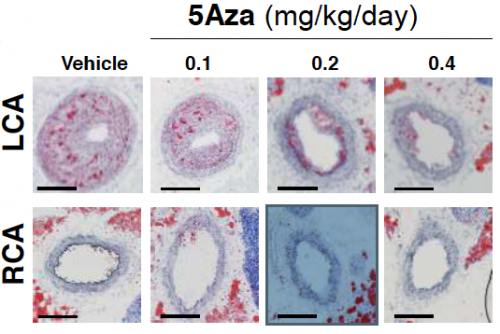Disturbance in blood flow leads to epigenetic changes and atherosclerosis

Disturbed patterns of blood flow induce lasting epigenetic changes to genes in the cells that line blood vessels, and those changes contribute to atherosclerosis, researchers have found. The findings suggest why the protective effects of good blood flow patterns, which aerobic exercise promotes, can persist over time. An epigenetic change to DNA is a chemical modification that alters whether nearby genes are likely to be turned on or off, but not the letter-by-letter sequence itself.
The results are scheduled for publication in the Journal of Clinical Investigation.
Atherosclerosis is the buildup of fats and inflammatory cells in arteries, a process that can lead to heart attacks and strokes. The curvature of arteries and resulting disturbed flow influence where atherosclerotic plaques develop. Biomedical engineer Hanjoong Jo and his colleagues have developed a model that allows them to see the inflammatory effects of disturbed blood flow quickly. Jo is professor of biomedical engineering in the Wallace H. Coulter Department of Biomedical Engineering at Georgia Tech and Emory University.
"This new study shows that disturbed blood flow induces epigenetic changes that lead to atherosclerosis," Jo says. "It had been known for a long time that plaques preferentially develop in curved and branched arteries, but our lab has been able to prove that disturbed blood flow can actually trigger atherosclerosis, in the presence of risk factors such as high blood cholesterol."
Despite the demonstrated importance of blood flow patterns in atherosclerosis, it can be blocked in mouse models with a drug that interrupts the process of DNA methylation, an epigenetic change that often turns genes off. Jo's team has identified several genes that become turned off under disturbed flow conditions, in a way that requires DNA methylation. Some of these genes may represent new therapeutic targets in atherosclerosis.
The co-first authors of the JCI paper are biomedical engineering graduate students Jessilyn Dunn and Haiwei Qiu, and postdoc Soyeon Kim, PhD.
In the Jo lab's mouse model, researchers restrict blood flow in three carotid arteries on one side, in the presence of a high-fat diet. In a 2010 paper in Blood, they had found that one of the genes induced by disturbed blood flow is DNMT1, encoding a DNA methyltransferase enzyme.
DNMT1 carries out DNA methylation, an epigenetic modification of DNA. Changes in DNA methylation are important for cells differentiating into different tissues such as blood, muscle or bone, and for the development of cancer.
Dunn and her colleagues found that treatment with 5-aza-2'-deoxycytidine, a drug that is now used to treat acute myeloid leukemia, can prevent atherosclerotic plaques from forming in the mouse model.
"While we do not envision using 5-aza for atherosclerosis treatment clinically, our results do reveal potential therapeutic targets," Jo says.
A broader implication is that improving blood flow patterns, through aerobic exercise for example, can induce a lasting imprint on gene expression in the blood vessels, he says.

















